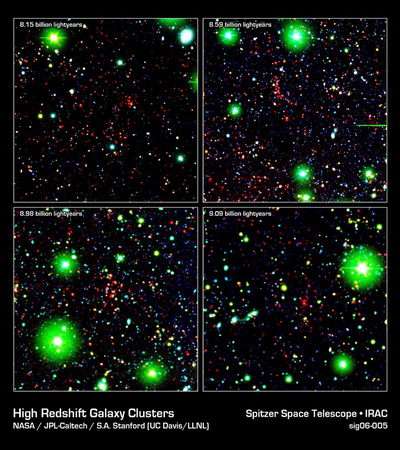Spitzer Sees 9 Billion Years Back in Time

Astronomers using NASA's Spitzer Space Telescope have conducted a cosmic safari to seek out a rare galactic species. Their specimens - clusters of galaxies in the very distant universe - are few and far between, and have hardly ever been detected beyond a distance of 7 billion light-years from Earth.
To find the clusters, the team carefully sifted through Spitzer infrared pictures and ground-based catalogues; estimated rough distances based on the cluster galaxies' colors; and verified suspicions using a spectrograph instrument at the W.M. Keck Observatory in Hawaii.
Ultimately, the expedition resulted in quite a galactic catch - the most distant galaxy cluster ever seen, located 9 billion light-years away. This means the cluster lived in an era when the universe was a mere 4.5 billion years old. The universe is believed to be 13.7 billion years old.
"Detecting a galaxy cluster 9 billion light-years away is very exciting," said the study's lead investigator, Dr. Peter Eisenhardt of NASA's Jet Propulsion Laboratory. "It's really amazing that Spitzer's 85-centimeter telescope can see 9 billion years back in time."
Using the same methods, the astronomers also found three other clusters living between 7 and 9 billion light-years away.
"Spitzer is an excellent instrument for detecting very distant galaxy clusters because they stand out so brightly in the infrared," said co-investigator Dr. Mark Brodwin, also of JPL. "You can think of these distant galaxy cluster surveys as a game of 'Where's Waldo?' With an optical telescope you can spot 'Waldo,' or the distant galaxy clusters, by carefully searching for them amongst a sea of faint galaxies."
"But in the Spitzer data, it's as though Waldo is wearing a bright neon hat and can be easily picked out of the crowd," Brodwin added.
Galaxy clusters are the largest gravitationally bound structures in the universe. A typical cluster can contain thousands of galaxies and trillions of stars. Because of their huge size and mass, they are relatively rare. For example, if Earth were to represent the entire universe, then countries would be the equivalent of galaxies, and continents would be the galaxy clusters.
Galaxy clusters grow like snowballs, picking up new galaxies from gravitational interactions over billions of years. For this reason, team members say these behemoths should be even rarer in the very distant universe.
"The ultimate goal of this research is to find out when the galaxies in this and other distant clusters formed," said co-investigator Dr. Adam Stanford, of the University of California at Davis. Stanford is the lead author of a paper on the most distant galaxy cluster's discovery, which was published in the December 2005 issue of Astrophysical Journal Letters.
The 9 billion-year-old cluster is just one of 25 the team captured on their Spitzer safari. They are currently preparing for more observations this spring at the W.M. Keck Observatory to confirm the distance of additional galaxy clusters from their sample. According to Eisenhardt, some of the clusters awaiting confirmation may be even more distant than the current record holder.
Source: NASA, by Linda Vu


















